How I implanted RFID into my hand, and then NFC. Part 2
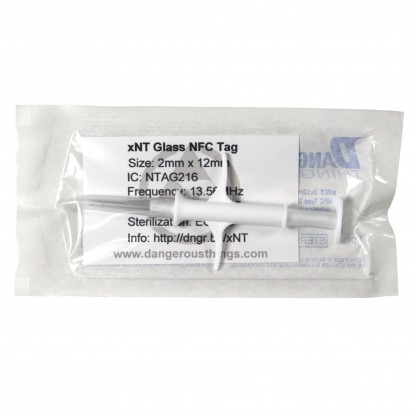
The advantages of the first 125 kHz tags were immediately noticeable - the key to intercoms and internal locks, but I wanted more - to unlock the phone, laptop, to store data in a protected place. All this allows you to make the label NFC standard.
In more detail about the implantation process without the help of outsiders, the use and disadvantages - under the cut.
ATTENTION! This publication is not an instruction, recommendation, guide to action and is intended for reference only. Repeating the following can be fatal or lead to complications and injuries. The author does not recommend performing the described actions on himself and is not responsible for any consequences caused by reading the publication.
')
NFC, ISO14443 and Mifare
Standards of near radio communications and wireless tags in particular, there is a great variety. The most commonly used frequencies are 125 kHz (LF-band, see the first part, the most frequent representatives are EM-Marin, HID Proximity), 13.56 MHz (HF-band, representatives are the Mifare family, the HID iClass family) and 860-960 MHz (UHF).
In general, within each range, there is such a jumble of ISO standards, extensions of ISO standards by other, but compatible, commercial names of families and products that partially or fully implement one of the standards. This can add complexity and unexpected problems when you expect your label to open this door, and the standard is not really the same - and nothing works.
Let's take a quick look at the basic standards:
ISO 14443 is one of the basic standards for wireless access cards, defines the operating frequency (13.56 MHz), limit distance (10 cm), other physical parameters of the interface, speeds (up to 106 kbaud / s in the original standard) and data transfer protocols between reader and card, determination of collisions, if there is more than one card in the reader field, etc. The standard does not specify the encryption used, as well as the exact format of the data on the card.
ISO 15693 is a less common standard that is incompatible with the previous one. It assumes the same operating frequency, but a lower data exchange rate (up to 26 kbaud / s) in exchange for a longer reading distance.
NFC - Near Field Communication is a fairly large set of standards, partially compatible with ISO 14443, describing both the physical interface layer (generally based on ISO 14443) and much more, the NDEF data storage format (standardizing ways to encode URLs, contact data, and more .d.), ISO 14443 compatibility mode. Thanks to the latter, each NFC device (and RFID tag and smartphone) can at least return its identification number in a format understandable to the reader designed for older cards. Well, the NFC reader is usually able to read other RFID cards that are not NFC but also based on ISO 14443.
MIFARE is a large family of standards, also based on ISO 14443, differing in memory size (from hundreds of bytes to tens of kilobytes), encryption (from the absence or proprietary algorithm to AES \ DES), often used as access cards, payment cards.
xNT Glass NFC Tag
At KDPV it was he. A smooth 2x12 mm glass cylinder containing a standard NXP NTAG216 chip and a compact antenna is supplied immediately in a sterilized form inside a special syringe.
The label in this performance was made by the guys from Dangerous Things during the campaign on Indiegogo , which collected more than 30 thousand dollars with the required 8 thousand.
In 2014, after the implantation of the EM4100, this chip was found, it was ordered and successfully arrived by Russian Post to me. Then he cost $ 99 (as much now) plus $ 28 delivery.
Implantation process
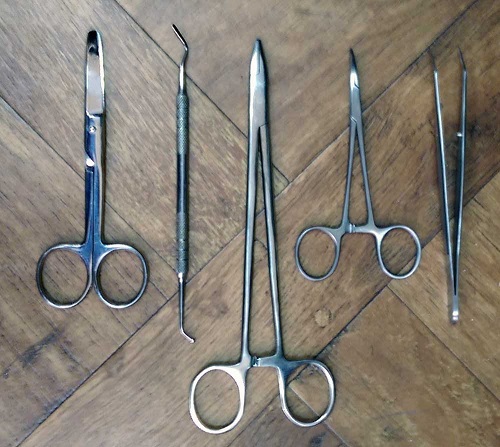
No, in fact, none of this is needed! This is a picture of the tools from the first part of the article.
Since the label comes already sterilized and in the syringe, its implantation is much simpler, without any problems being performed independently without any help. In general terms, the process looks like this:
- Choosing a place to place tags As already mentioned in the first part, the space between the thumb and index fingers of the hand is most often chosen, since this place is usually not under pressure in everyday life. If there are more than one mark, like mine, it is undesirable to place them very close, it is better to retreat 1-2 cm from each other.
- Anesthesia with novocaine - we introduce a solution of novocaine 20 mg / ml subcutaneously into the intended incision site, simultaneously moving the tissues apart and simplifying the further placement of the mark, waiting for 5-10 minutes to penetrate into the surrounding tissues. Be careful with Novocain - if you have allergies and / or crooked hands, it can cause many of the most unpleasant consequences, even death! Do not do it yourself if you are not a doctor. Also, do not do it alone and be prepared to call an ambulance, if that.
In principle, the anesthesia can be skipped, it is not so difficult to survive the injection of a thick needle into the arm. In this case, it is desirable that the introduction of the label is not done by yourself, but by the other person — in order to make a skin fold with the other hand. - Implantation - wipe the skin twice with alcohol, pierce the skin fold or “bubble” with novocaine, holding the needle almost horizontally to the skin, insert the needle 15-20 mm, then, pressing the syringe piston, squeeze the mark through the needle under the skin. Carefully remove the needle.
Here's a video (not mine) about how it looks: - Completion - the incision in this case is even smaller than it was the first time, so it is enough just to glue it with adhesive tape. If everything was done correctly, in 3-5 days the plaster can be removed, and only a small scar will remain on the skin, which will disappear completely after a few months. If during these days the temperature rises - again, we go to the doctor, without delay.
How was it with me
Having some knowledge of medicine, I decided to do everything on my own. Actually, there were no problems :) Those who wish to repeat - for the third time I will offer to reread the warning at the beginning of the article.
Under the spoiler a few photos with gloves, a plaster and a small amount of blood
We put a glove on one hand ...
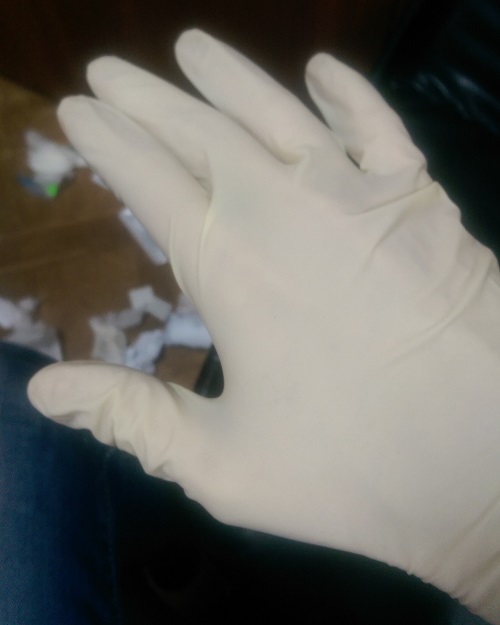
We inject novocaine, wait, enter the label, remove excess blood, scattering everything around at the same time because there are only two hands.
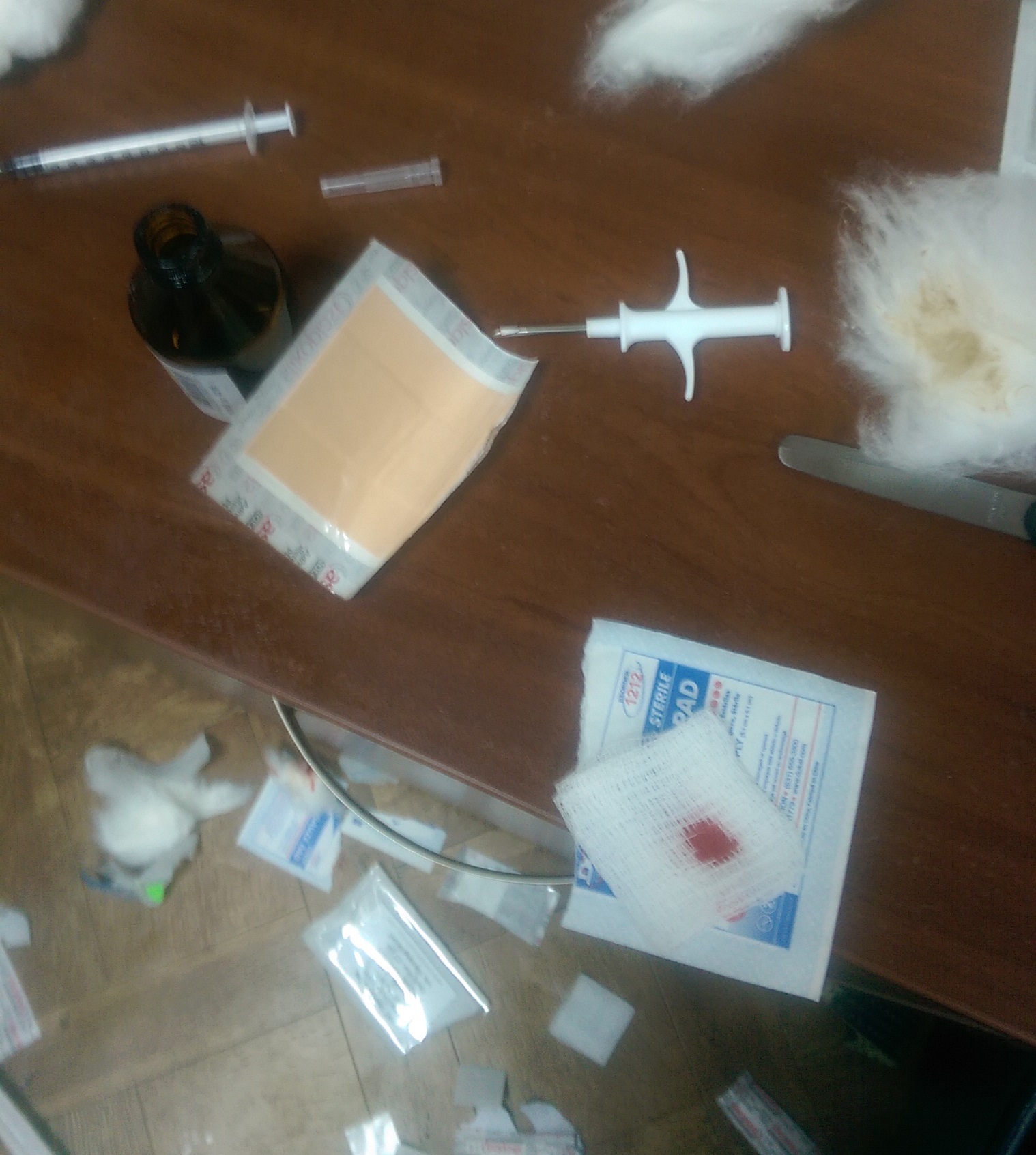
We glue with a plaster.
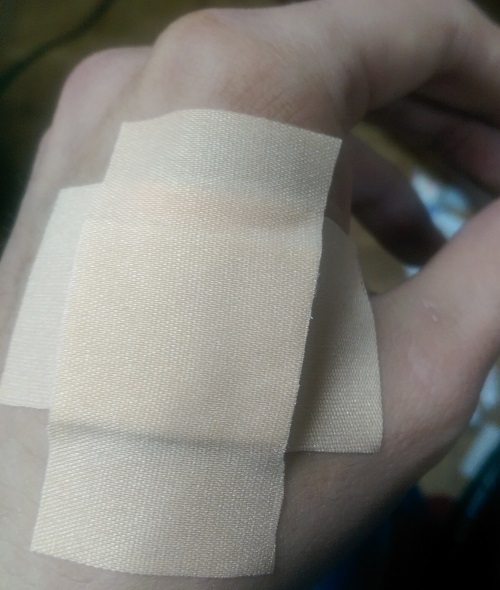

We inject novocaine, wait, enter the label, remove excess blood, scattering everything around at the same time because there are only two hands.

We glue with a plaster.

Smartphones and laptops
Further - how to apply it? Most of all, I was interested in the possibility of using tags for quick unlocking of the equipment - in 2014, the fingerprint sensors were not everywhere, they were not in my smartphone and laptop.
Those programs that were in 2014 are no longer active, so I’ll just describe in general terms.
NFC on Android - xNT - a normal and fully-fledged label, so all the programs that you can find in the market on request NFC - work. You can store some information in your tag (for example, the private key of something, although it may not be very safe), you can automate actions when you put the tag to the phone.
Android unlock on NFC - in the market on request "nfc unlock" or "nfc logic" programs that fully perform this function, and for some time I used it on my HTC.
Unlocking Windows on NFC - here are two features. Firstly, NFC-tags are not considered to be full-fledged smart cards, and a third-party "provider" is required for their operation. Secondly, Windows does not allow the use of a smart card for local login, without a domain. Therefore, third-party software is required. I used a bundle from the NFC Connector and EIDAuthenticate , and as a reader - ACR-122U.
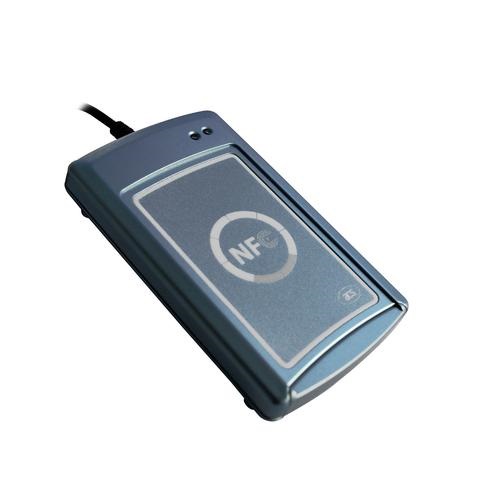
Disadvantages and problems
I use the label EM4100 now. And xNT Glass NFC Tag is not, and here's why:
- A very small radius of action - in fact, you had to move your hand for a while on the reader or the back surface of the smartphone, until the mark was finally in the desired position. My first 125 kHz tag worked much more stable.
- The lack of support in regular software — for Android and for Windows — required third-party software, which in the first case was rather “collective farm” and braking, and in the second - paid.
- The spread of fingerprint readers is even less protected (try to roll the sleeping person with your smartphone, trying to find the exact point!), But there is a “out of the box” and for me the security they provide was sufficient.
In general, about five years with tags
About the relative uselessness of the NFC-tag is written above. For the rest - no special problems. For almost five years, nothing has happened to the marks or to the very hand, the scars have long since disappeared, and there have not been any special pitfalls. Yes, it is still more convenient to open the doors with a “hand” than with a separate tablet. Yes, they can even be used in organizations as a pass, offering to register “your card” in the access control system and causing this a slight surprise - but no more.
If you have questions - ask, I will try to answer :)
Source: https://habr.com/ru/post/447104/
All Articles